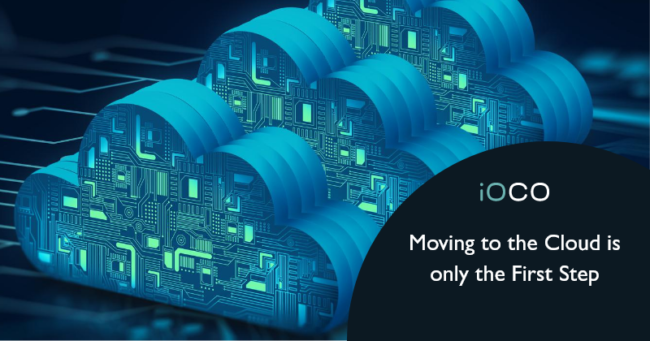So many options ahead of you…
During many of our cloud advisory engagements, we’ve seen customers start their cloud journeys but get stuck in a quagmire of how to progress next. Many organisations have moved to a form of cloud services but have yet to realise the full value and potential of the cloud ecosystem and all it has to offer. So, let’s first look at various options when it comes to your apps, and then some possible bumps that you may encounter during your cloud journey. Various teams in iOCO can jump in to remove these obstacles from your path, making the entire process of moving to the cloud seamlessly.
What’s next for your applications: Options after moving to the cloud
- Retain (Revisit) – “Keep and Reap”
Keep the application in its current form, at least for now. This doesn’t preclude revisiting it in the future.
- Retire – “Stop and Lop”
Get rid of the application completely.
- Rehost – “Lift and Shift”
Move the application to the cloud (IaaS) and continue to run it in more or less the same form as it currently runs.
- Replatform – “Lift, Tinker and Shift”
Move the application to the cloud and perform a few changes for cloud optimisation.
- Refactor – “Cut and Gut”
Rewrite the application, taking advantage of cloud-native architectures.
- Repurchase – “Drop and Shop”
Replace with an alternative, cloud-native application and migrate the data.
Some bumps you may encounter on the way
Whether your organisation has opted for a “Lift and Shift” or “Cut and Gut”, it does not mean you have completed your cloud journey; you have merely begun. Depending on your specific situation, you may encounter some of the following issues.
Defining cloud objectives
The reasons customers are struggling and the kinds of questions and concerns that are aired can provide valuable information, giving insights as to why these cloud initiatives have stalled or gotten side-tracked. Questions that arise at this stage include:
- “What applications should I move?”
- “Should I try to modernise all systems or just some? Which ones?”
- “How do cloud costs compare to my costs?”
- “What are my real costs?”
- “Exactly why are we moving to the cloud in the first place?”
- “What is the business benefit, and what are the risks?”
These insights help to define a strategy covering what is it your organisation wants to achieve by moving to the cloud. Do you want to digitise your platforms to accommodate younger clients, or do you want to utilise your IoT data to provide insight and innovation opportunities? We often encounter drives like data centre migration or executive mandates as strategies, but these are levers to move to the cloud, not definitions of what value you want to derive from the cloud. Our holistic approach helps you to achieve your cloud objectives and innovation aspirations.
What should stay and what should go?
The next area where we see customers encountering difficulties is what business applications to move and how to quantify the migration complexity of these on-premise applications. We have developed a process to analyse and prioritise these business applications, build strong business cases and ensure focused programme execution, having assisted large organisations to move forward effectively and methodically until all their cloud-ready applications are migrated. But not all applications can be moved and other options such as SaaS service or light to moderate development should be explored. Some applications have a unique composition and infrastructure investment criteria which makes them unsuitable for full cloud migration, and a hybrid approach may be required.
Preparing your people for the change efficiently
When migrating to public cloud providers or private cloud, many organisations underestimate the people preparation part for cloud readiness and focus only on the technical aspects of migration. There are many other areas the business needs to upskill and prepare for cloud services. These areas include legal, compliance, finance, security and data departments or professionals. We have developed a Cloud Centre of Excellence model for a large client to thoroughly prepare the organisation for cloud services and put policies, guard rails, technical capability and governance process in place before workloads are moved to a cloud platform. This approach enables you to migrate with confidence and skill. Furthermore, it allows you to manage cloud costs which go over budget if not analysed and planned properly. We have also helped build customer-specific migration templates/checklists that help speed up and ensure greater thoroughness during migrations.
Supporting you all the way
Once an organisation has started moving workloads to the cloud, management and operational issues need to be tackled. We work closely with hyper scalers and customers to ensure a smooth operating model and proper skills transfer. We can manage and operate cloud teams, providing partner support with the large hyper public cloud providers as an accredited partner solution provider, and apply best practices and cost analysis on a regular basis.
Dealing with legacy applications
Some workloads have traditional architecture and require modernisation to be able to run on cloud platforms. We can transform legacy applications to run on cloud platforms, helping clients with additional capacity during the transition and working together with the digital platform business to change paper-based systems to digital systems, thus automating manual processes to optimise application processes and systems.
How clean is that data?
Now that you have moved your workload to the cloud and modernised your applications, there is one last aspect that needs attention: all your valuable data and cleaning up that data before migrating. Ensuring that your data is secure and well-governed is vitally important before using data analytics and artificial intelligence to gather business intelligence and insights into any business operations. We specialise in governance, security, performance and data analysis and can play an invaluable role in assisting you to achieve your migration and value-creation cloud objectives.

